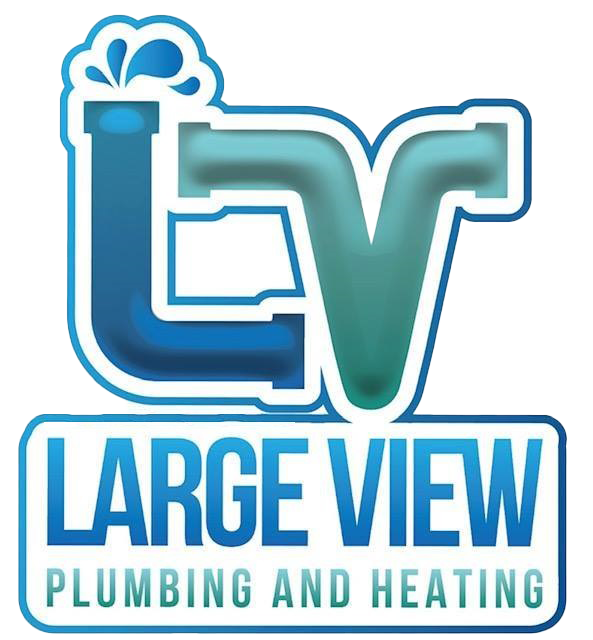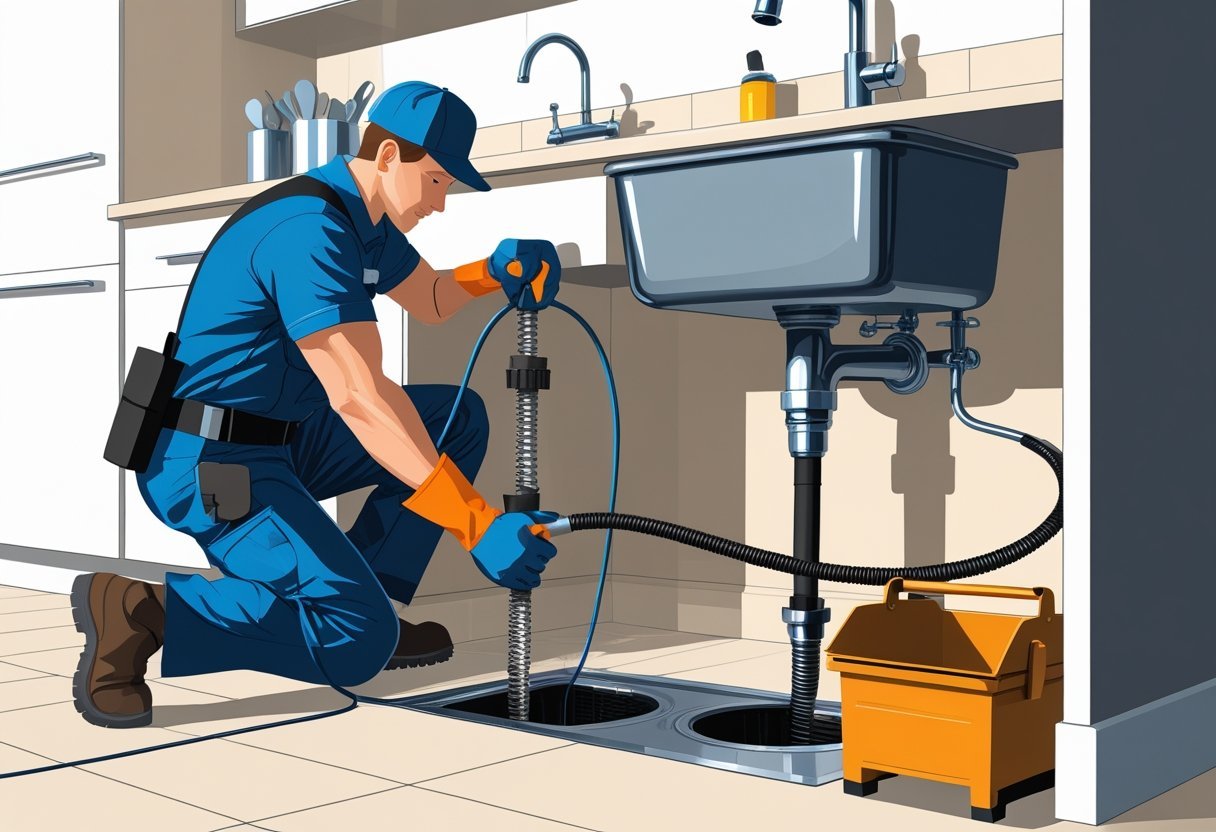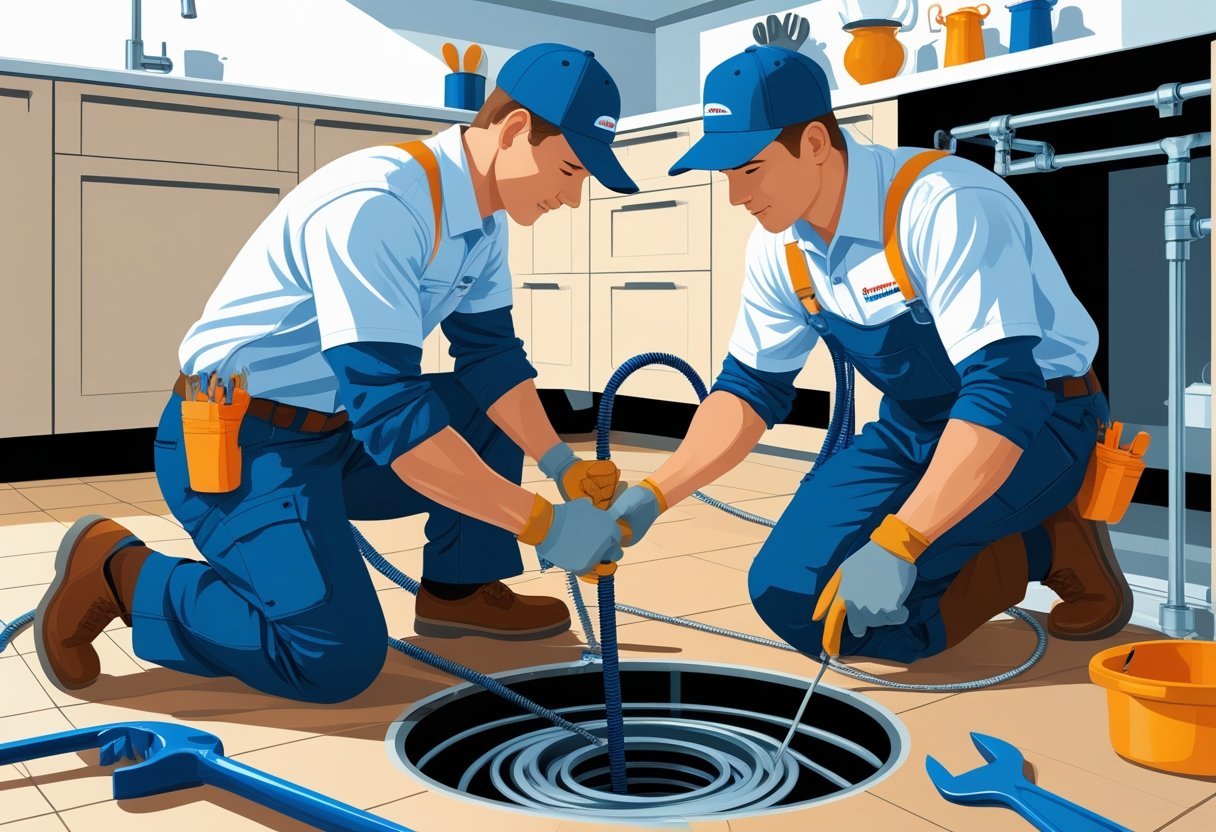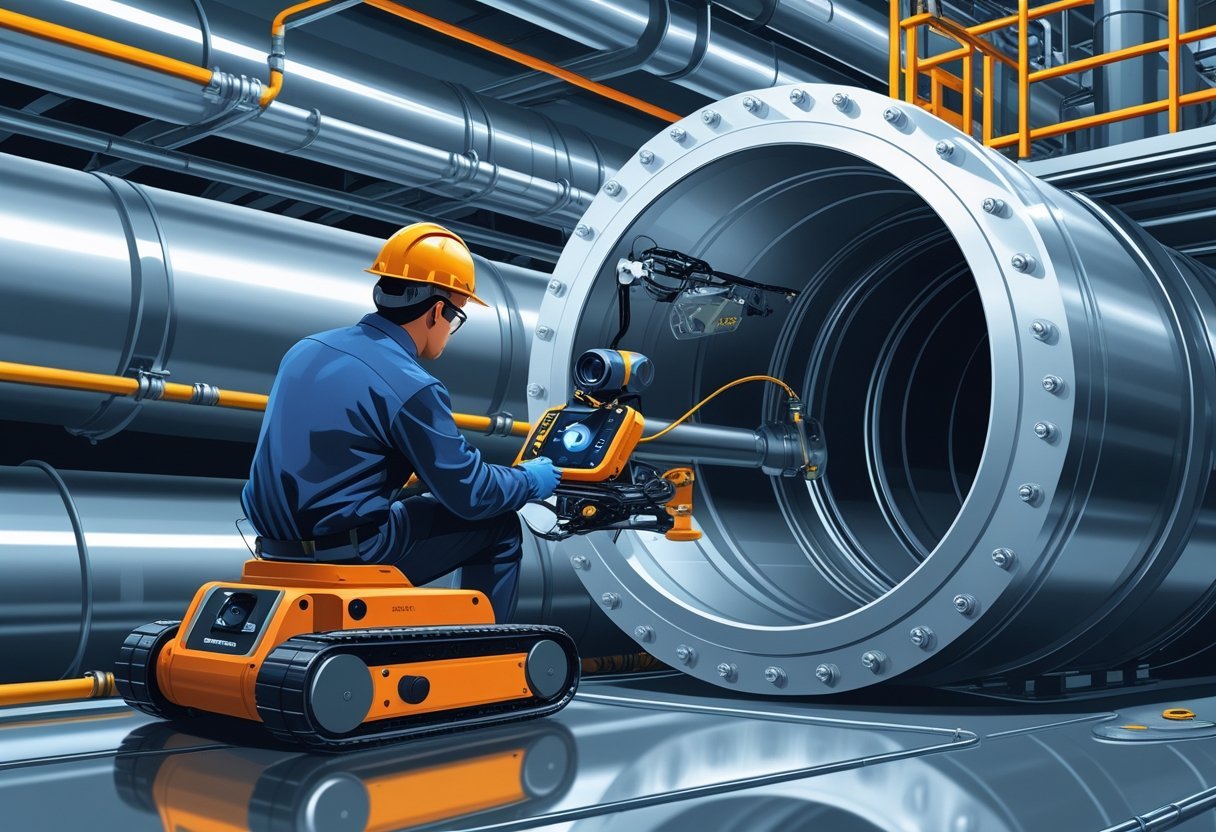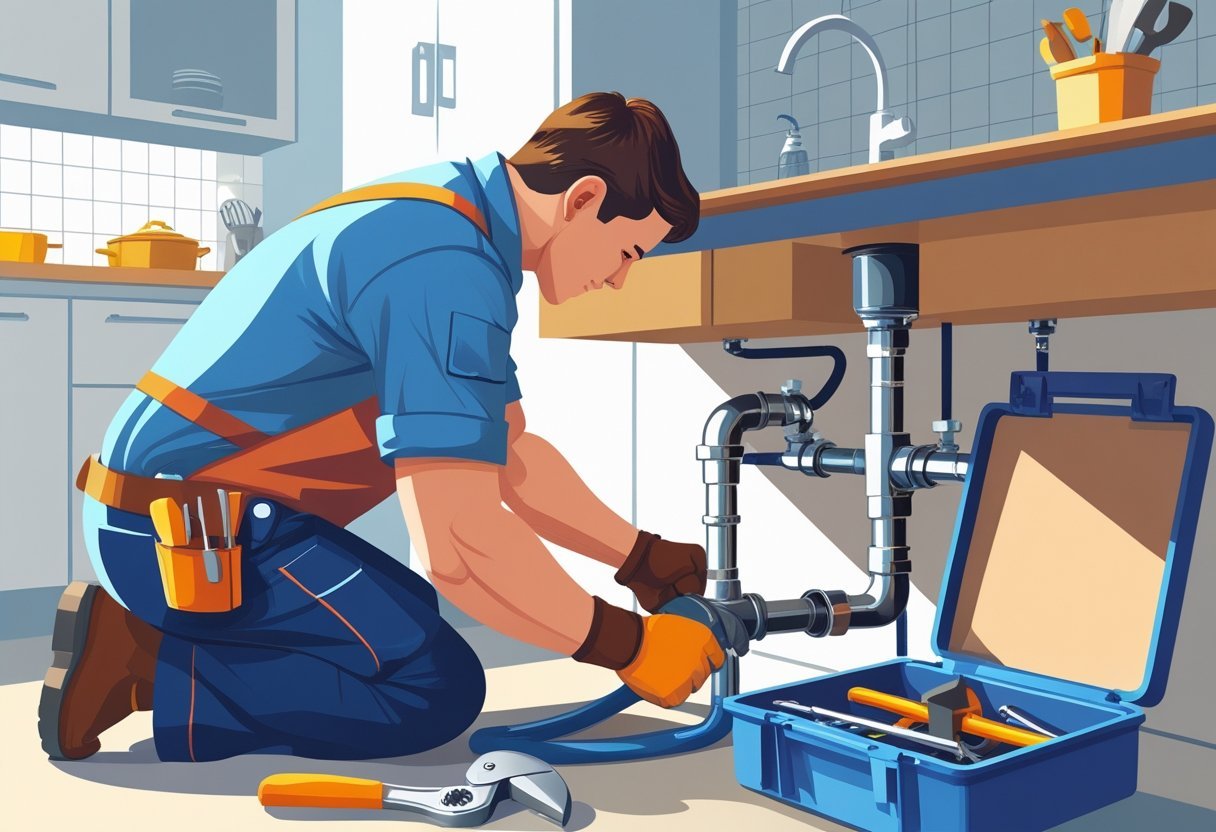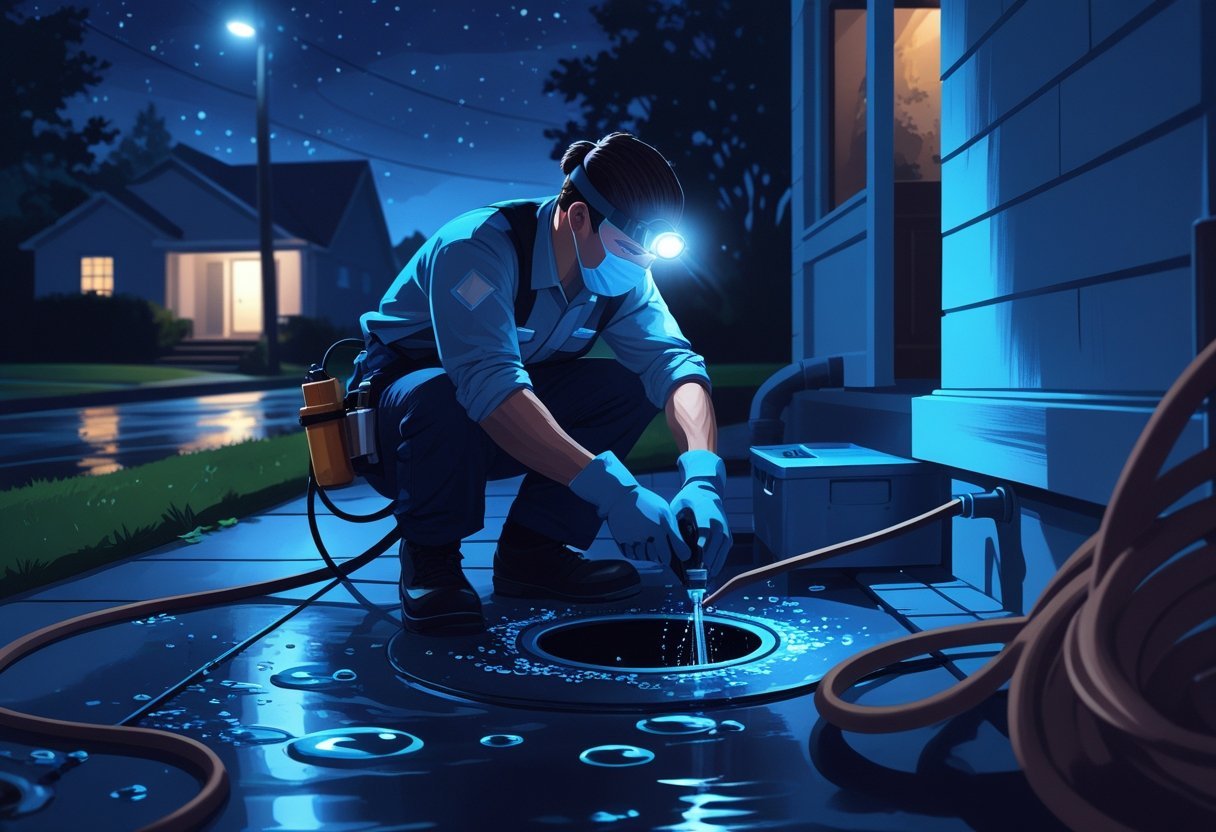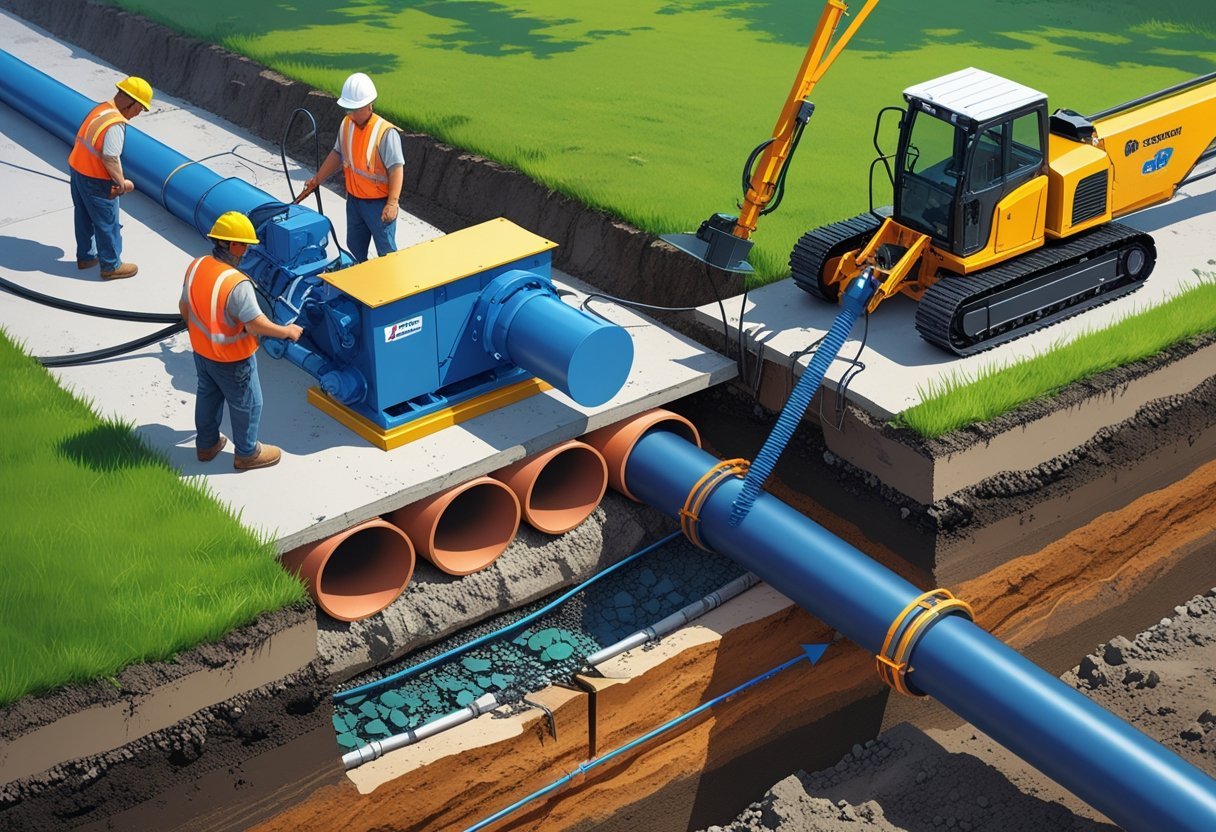Detecting underground drain pipe leaks can save you significant time, money, and damage to your property. The most effective way to identify these leaks is by using specialized methods like acoustic leak detection, ground-penetrating radar, or thermal imaging, which pinpoint the exact location without unnecessary digging. Understanding these techniques can help you act quickly and avoid costly repairs.
If you suspect a leak, relying on experienced professionals like Large View Plumbing & Heating in North Shore, Massachusetts, ensures accurate detection and efficient solutions. With over 10 years of experience and modern technology, their team can diagnose and repair leaks with minimal disruption to your property. Learning about how leak detection works empowers you to protect your plumbing system before small problems grow.
Understanding Underground Drain Pipe Leak Detection
Identifying leaks in underground drain pipes is essential for maintaining a reliable plumbing system. Detecting these leaks early helps you avoid costly repairs, water waste, and damage to your property. You need to understand what underground drain pipe leak detection entails, the causes behind these leaks, and their impact on your plumbing infrastructure.
What Is Underground Drain Pipe Leak Detection
Underground drain pipe leak detection involves locating leaks in pipes buried beneath soil or concrete. Because these leaks are hidden, specialized methods and technology are required to detect them accurately. Common techniques include acoustic sensors that pick up leak-generated sounds, thermal imaging cameras that reveal temperature changes, and ground penetrating radar to map pipe locations.
Professional plumbers like those at Large View Plumbing & Heating use these technologies combined with visual inspections and pressure testing to pinpoint leaks without extensive digging. Detecting the problem early preserves pipe integrity and helps you avoid major excavation or pipe replacement costs later.
Common Causes of Underground Pipe Leaks
Pipe leaks underground often stem from physical damage, material degradation, or shifting soil. Copper pipes, while durable, can corrode over time due to soil acidity or moisture levels. Tree roots are another frequent culprit; they grow towards moisture and can penetrate or crush pipes, causing leaks.
Other factors include poor installation, accidental damage during landscaping or construction, and freezing temperatures leading to pipe bursts. Knowing these causes lets you take preventative measures like soil treatment, root barriers, or regular inspections to catch issues before leaks worsen.
How Leaks Impact the Plumbing System
Leaks in underground pipes disrupt your entire plumbing system. They reduce water pressure, increase utility costs due to wasted water, and can contaminate soil or groundwater if sewage or chemicals are involved. Over time, persistent leaks undermine pipe stability, encouraging further cracking or collapse.
Moreover, underground leaks often go unnoticed until they create visible damage, such as sinkholes, wet spots on your lawn, or foul odors. By addressing leaks promptly, you protect your home’s foundation and ensure the longevity of your plumbing infrastructure. Experts from Large View Plumbing & Heating can provide routine maintenance and advanced leak detection to safeguard your system effectively.
Identifying Early Signs of Underground Drain Pipe Leaks
Leaks beneath your property often remain hidden until they cause significant issues. However, there are specific signals you can watch for that suggest a leak is present. These include changes in your water bill, water pressure, and visible dampness or damage around your home.
Unexplained Increase in Water Bill
A sudden, unexplained increase in your water bill is one of the most common early signs of an underground drain pipe leak. Even if your water usage habits haven’t changed, leaks can waste large amounts of water, driving up costs.
Check your bill carefully for spikes that don’t align with seasonal or household changes. A high water bill often means water is escaping underground, where it’s not visible. Large View Plumbing & Heating can help pinpoint leaks causing these unexpected charges so you don’t pay for wasted water.
Drop in Water Pressure
If you notice a persistent drop in water pressure throughout your home, it may indicate a leak in your underground drain pipes. Leaks reduce the volume of water that reaches your faucets and appliances, resulting in weaker flow.
Low pressure unrelated to other plumbing issues is a sign to investigate. You might observe this when multiple fixtures lose pressure simultaneously. Don’t ignore this symptom, as ongoing leaks can cause bigger problems if left unattended.
Wet Spots and Damp Areas
Wet or damp patches in your yard, driveway, or basement walls without an obvious cause can signal an underground drain pipe leak. These areas remain moist because water is seeping into the soil from damaged pipes.
Look for unusual pooling or soggy ground that doesn’t dry, especially near pipe runs. These spots may also attract insects or mold. Such visible signs require timely evaluation to avoid further water damage to your property structure.
Detecting Mold Growth and Structural Damage
Mold growth and structural damage often follow prolonged exposure to moisture from underground leaks. Moist conditions behind walls or under floors promote mold, which can harm indoor air quality and your health.
You may notice musty odors, discoloration on walls, or warped flooring. These are serious indicators that water is leaking under your home, causing damage to foundations or framing. Early detection and repair by experts like Large View Plumbing & Heating help prevent costly repairs and protect your property’s integrity.
Top Methods for Detecting Underground Pipe Leaks
Detecting leaks in underground drain pipes requires specific approaches suited to hidden and often hard-to-access locations. You need accurate, minimally invasive methods that help pinpoint leaks without unnecessary digging or damage.
Visual Inspection Techniques
Visual inspection is often your first step, even with underground pipes. Look for visible signs like unusual wet spots, muddy areas, or sinkholes near your drain lines. These surface clues may suggest a leak below.
If accessible, expose manholes, cleanouts, or inspection ports to check for odors or moisture. Sometimes, cracks or corrosion visible on nearby exposed sections can indicate pipe damage underground.
Regular monitoring of your yard’s condition and landscaping changes helps identify potential trouble spots early. Though limited, visual inspection guides further, more advanced detective work.
Using Water Meter for Leak Detection
Your water meter can reveal hidden leaks effectively. Begin by ensuring no water is used in your home for a few hours. Check the meter reading at the start and end of that period; any movement suggests ongoing leakage inside or outside the house.
This method is cost-effective and simple but tells you only if a leak exists, not where. For underground drain pipes, it signals the need for more precise tools.
Large View Plumbing & Heating frequently uses water meter readings as a diagnostic tool before moving to ultrasonic or pressure testing technologies to find exact leak locations.
Acoustic Leak Detection
Acoustic leak detection relies on sound technology to identify leaks from the noise of escaping water. Specialized devices detect high-frequency sounds produced by leaks, even underground.
This method is highly sensitive and can localize leaks without excavation. You place sensors along pipe runs and listen for abnormal sounds like hissing or tapping.
Acoustic detection works best in quiet environments and with metal or plastic pipes, making it ideal for many residential plumbing systems. Experts at Large View Plumbing & Heating often employ this to locate leaks efficiently while minimizing disruption.
Pressure Testing for Pipe Leak Detection
Pressure testing involves sealing a section of pipe and introducing air or water under higher pressure than normal. Monitoring pressure drop over time indicates if and where leaks exist.
This approach is accurate and useful for detecting leaks that are otherwise undetectable. It requires specialized equipment to pressurize pipes safely and observe pressure decay.
Pressure tests are standard in both new installations and leak diagnosis. When combined with other methods, such as acoustic detection, it confirms leak presence and helps determine repair priorities.
Advanced Technologies in Underground Leak Detection
Detecting leaks in underground drain pipes requires precise and efficient technology to avoid costly damage and invasive excavation. The methods used focus on pinpointing leaks through temperature differences, subsurface imaging, or moisture detection, allowing you to act quickly and minimize disruption.
Thermal Imaging and Infrared Cameras
Thermal imaging uses infrared cameras to detect temperature variations on the ground surface caused by leaking water. When water escapes from a pipe, it typically cools or warms the surrounding soil, creating a distinct thermal signature.
These cameras capture heat patterns invisible to the naked eye, allowing you to locate leaks without digging. The technology is non-invasive and effective for both plastic and metal pipes.
With thermal imaging, you can identify even slow leaks early, which helps prevent extensive damage. Companies like Large View Plumbing & Heating use this technology to provide precise leak detection and quick response.
Ground-Penetrating Radar
Ground-Penetrating Radar (GPR) emits electromagnetic waves into the ground to create detailed images of underground structures, including drain pipes. When waves reflect off different materials, the radar detects anomalies indicating leaks or pipe damage.
GPR works well regardless of soil type and can differentiate between pipe materials such as concrete, PVC, or metal. It provides a real-time view of subsurface conditions, which makes it useful not only for leak detection but also for planning repairs or replacements.
Because GPR is non-destructive, it reduces the need for extensive excavation. This technology is critical when you want to preserve landscaping or pavement while accurately locating problems.
Moisture Meters and Pipe Inspection Cameras
Moisture meters help you detect elevated moisture levels in soil or walls caused by leaks, providing an indirect but effective indication of underground drain pipe issues. They measure water content in materials and can quickly confirm suspected leak areas.
Pipe inspection cameras offer a direct visual assessment by navigating the inside of pipes using remote-controlled, high-resolution cameras. This method lets you see blockages, cracks, or holes causing leaks.
Together, moisture meters and inspection cameras form a complementary approach: moisture meters help narrow down the leak zone, and cameras confirm the exact problem. Large View Plumbing & Heating combines these tools to ensure accurate diagnosis and efficient repair.
Using these advanced methods, you can detect underground drain pipe leaks with minimal disruption and prompt intervention.
Mitigating Damages and Addressing Underground Leaks
Underground water leaks require prompt action to prevent escalating damage and costly repairs. Understanding the risks and involving professional plumbers early ensures effective detection, repair, and long-term protection of your property.
Consequences of Neglected Underground Water Leaks
Ignoring an underground water leak can lead to serious property damage over time. Moisture accumulation under foundations weakens structural integrity, risking cracks and even collapses. Water loss from leaks also drives up your utility bills, sometimes without obvious signs.
The soil surrounding pipes can erode, causing sinkholes or uneven ground that jeopardizes driveways and landscaping. Untreated leaks may also promote mold growth, creating health hazards inside your home. You lose significant water volume, which affects sustainability and water conservation efforts.
Professional Plumber Involvement
When you detect a possible water leak underground, calling a professional plumber like Large View Plumbing & Heating will help you quickly locate and assess the issue. Experienced plumbers use advanced tools such as acoustic leak detection, thermal imaging, and ground-penetrating radar to pinpoint leaks without excessive excavation.
Professional plumbers evaluate your plumbing system’s condition and recommend the best repair approach, saving you time and expense. You gain peace of mind knowing experts are addressing the problem with precision and care, minimizing disruptions to your property.
Repair and Remediation Strategies
Upon confirmation of an underground water leak, repair strategies depend on the leak’s size and location. Trenchless pipe rehabilitation is often preferred, allowing pipe repair or replacement with minimal digging. This reduces surface damage to your yard or driveway.
For localized leaks, plumbers may excavate small sections for direct pipe repair. After repairs, proper soil compaction and restoration prevent future issues like soil shifting or sinking. Installing leak detection systems can monitor for future water leaks underground and alert you early.
Large View Plumbing & Heating offers modern solutions tailored to your property to mitigate damage and restore your plumbing efficiently. Maintaining regular professional inspections helps you avoid costly leaks and keeps your system operating reliably.
Preventing Future Underground Pipe Leaks
To minimize the risk of underground pipe leaks, you need a combination of ongoing care, timely upgrades, and smart habits. Proper maintenance, investing in durable materials, and understanding your plumbing system’s needs all help protect your property from costly damage.
Regular Plumbing System Maintenance
Routine inspections and maintenance are critical. You should schedule regular checks of your plumbing system, especially the underground pipes, to catch early signs of corrosion, cracks, or shifting caused by soil movement.
Look for unusual wet spots, dips in your yard, or unexplained increases in your water bill as potential indicators of a hidden leak. Pressure testing and professional leak detection tools can help pinpoint small leaks before they become major issues.
Additionally, cleaning drains and ensuring proper pipe insulation reduce strain on your system. Large View Plumbing & Heating recommends setting up a maintenance plan that includes yearly inspections to extend your plumbing’s lifespan and prevent sudden failures.
Upgrading and Replacing Pipes
Old or damaged pipes are common culprits of underground water leaks. Replacing outdated materials such as galvanized steel or aging cast iron with modern alternatives like PVC or PEX reduces the risk of corrosion and breaks.
Consider trenchless pipe repair techniques, which Large View Plumbing & Heating utilizes, to minimize disruption to your landscape during replacement or rehabilitation. These modern methods are less invasive and often quicker than traditional digging.
Upgrading your system proactively can save money in the long run by preventing emergency repairs. Prioritize pipes in areas prone to soil shifts or heavy vehicle traffic, as these factors increase damage risks.
Best Practices for Homeowners
You play a key role in preventing leaks. Avoid planting trees or large shrubs close to underground pipes since roots may infiltrate and damage them. Also, be cautious with soil grading to ensure water drains away from your home rather than pooling near pipes.
Use water conservatively and monitor your water bill regularly for sudden spikes that may indicate a hidden pipe leak. Installing water sensors or alarms near crucial plumbing zones can alert you early to potential problems.
Educate yourself on your property’s plumbing layout and schedule professional water leak detection if you suspect any issues. Taking these steps helps you manage risks effectively and maintain the integrity of your underground plumbing system.
Frequently Asked Questions
Detecting leaks in underground drain pipes requires careful assessment and the right tools. You need to identify unusual signs, choose effective methods, and understand the costs and technologies involved for accurate detection. Some approaches suit professional use, while others may be attempted on a DIY basis.
How can you detect a leak in underground drain pipes?
You can detect leaks by observing wet spots, sinkholes, or unusual dampness on your property. Unexplained increases in water bills and the sound of running water when all faucets are off also indicate leaks. Professionals use acoustic listening devices and pressure testing to confirm the location precisely.
What are the best methods for locating leaks in underground drainage systems?
Acoustic leak detection, thermal imaging, ground penetrating radar, soil probes, and pressure testing are among the best techniques. Each provides unique benefits depending on the pipe material, soil conditions, and leak size. Hiring experts like Large View Plumbing & Heating ensures you get accurate detection using these advanced methods.
How much does professional underground leak detection typically cost?
Costs vary based on the complexity and size of the job but usually range from a few hundred to over a thousand dollars. Factors influencing price include the detection methods used and how easily the leak can be accessed. Getting a free consultation from trusted professionals can help clarify costs upfront.
What new technologies are being used for detecting leaks in subterranean water pipes?
Modern solutions include non-invasive acoustic sensors, advanced thermal cameras, and smart water meters. Trenchless technology also enables repair without extensive digging, reducing property damage. Companies like Large View Plumbing & Heating use these innovations to provide efficient and precise leak detection services.
Is it possible to locate underground pipe leaks using DIY techniques?
Basic tests like monitoring the water meter after shutting off all water sources can indicate a leak’s presence. You can also look for visual signs like soggy soil or unusual plant growth. However, precise location usually requires specialized tools and expertise beyond most DIY capabilities.
Can underground water leaks be found using rental equipment, and how effective is it?
Rental equipment such as electronic listening devices and pressure gauges is available but may require skill to operate correctly. Effectiveness depends on your experience and the tool’s quality. For accurate results and to avoid unnecessary digging, professional services are generally recommended.
